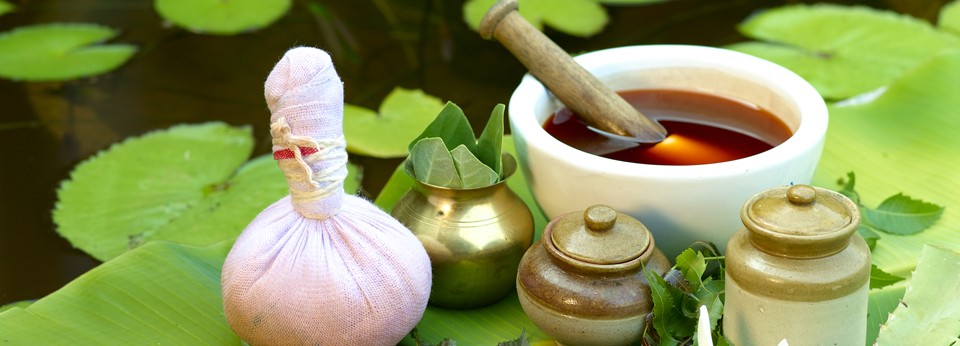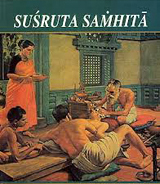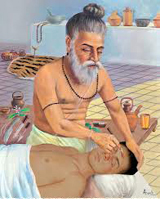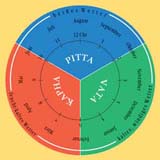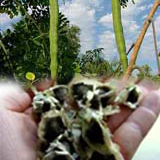Ayurveda
Āyurveda and cancer management — a literature review
Abstract
This article provides a general outline of cancers in Āyurveda and their management from an Āyurvedic practitioner’s perspective. It includes a summary of factors vitiating the three doṣas, the Āyurvedic concept of pathogenesis of tumours, different modalities of treatment and the various herbs and preparations used as therapy.
Introduction
Cancer can occur in all living cells and different cancer types have a different natural history. Multi-disciplinary scientific investigations are making their best efforts to combat this disease, but a perfect cure has yet to be introduced. Recently, a greater emphasis has been given towards research in complementary and alternative medicine to deal with cancer management. Several studies have been conducted on herbs under a multitude of ethno-botanical grounds. From very early times, Āyurveda, the traditional Indian medicine, has been successful in using plants to help prevent or suppress various tumours using various treatments.
Āyurvedic concept of cancer
The Caraka [1000BC] and Suśruta [800BC] saṁhitās, two well-known Āyurvedic classics, describe cancer as either granthi (minor neoplasm) or arbuda (major neoplasm). Āyurvedic literature defines three body-control systems (doṣas), viz., vāta, pitta, and kapha, which mutually coordinate to perform the normal functions of the body. In a benign neoplasm (vātaja, pittaja or kaphaja), one or two of the three bodily systems get out of control. This is not too harmful because the body is still trying to coordinate these systems. Malignant tumours (tridoṣaja) are very harmful because all three major bodily systems lose mutual coordination and thus cannot prevent tissue damage, resulting in a deadly condition.
Classification according to Āyurveda
The Āyurvedic classification of growths depends on various clinical symptoms:
Arbuda
For example, māṁsārbuda (melanoma) and raktārbuda (leukaemia), mukhārbuda (oral cancer), etc.
Gulmas
For example, tridoṣaj gulmas (abdominal tumours like carcinomas of the stomach and liver or lymphomas).
Miscellaneous
Diseases with the possibility of malignancy, e.g. visarpa (erysipelas), asadhya kamala (incurable jaundice) and nadi vrana (sinusitis).
Aetiology
According to Suśruta, the fundamental cause of the above is a derangement of all three doṣas. He described a sixth layer of the sheaths in a human body as rohiṇī, and pathogenic injuries to this layer (in muscular tissues and blood vessels) caused by lifestyle errors, unhealthy foods, poor hygiene and bad habits results in the derangement of doḍas, which can lead to the manifestation of tumours. The stability and rigid confinement of the doḍas in a particular place were described as reasons for the non-infectious and non-suppurative nature of these abnormal growths. This resulted in an excess of water or fat in the corpus of the tumour. Cancer in each person differs according to the person’s exposure to deranging factors and the constitution which make each person react differently to the same environmental factors. The factors responsible for the vitiation of doḍas are discussed here.
1. Vāta aggravating factors: excessive intake of bitter, pungent, astringent, dry foods and stressful conditions.
2. Pitta aggravating factors: excessive intake of sour, salty, fried foods and excessive anger.
3. Kapha aggravating factors: excessive intake of sweet, oily food and a sedentary nature.
4. Rakta aggravating factors: excessive intake of acid or alkali containing foods. Fried and roasted foods, alcoholic beverages, sour fruits are some examples. Excessive anger or severe emotional upset, sunbathing or working under a scorching sun or near a fire and in hot conditions, etc. are some other causes.
5. MāṀsa aggravating factors: excessive use of exudative foods like meat, fish, yoghurt, milk and cream. Behaviour leading to exudation, like sleeping during the day and overeating are some of the causes for derangements in tissues.
6. Meda aggravating factors: excessive intake of oily foods, sweets, alcohol and a lazy attitude.
Pathogenesis
According to Āyurvedic principles, a disease cannot be named as an entity in itself as its presentation differs according to the doṣa-constitution of the person. Thus, the pathogenesis in Āyurveda is explained on the basis of tridoṣas. Agni or pitta, which is present in each and every cell, is responsible for digestion and metabolism in the human body. A decrease in agni creates an increase of tissue and therefore in arbuda, the decreased state of dhātvagni (deranged metabolism) will result in excessive, uncontrolled tissue growth. Vāta can be correlated with the anabolic phase of growth whereas kapha to the catabolic phase. Cancer originates due to an imbalance of vāta and kapha, i.e. aggravation of vāta forces and suppression of kapha forces, both interacting with each other resulting in proliferation. It was seen that abnormal growths in a specific place (ekadeśavṛddhi) were managed by compensation from other parts of the body (anyasthānīyakṣaya), e.g. body weight loss (cachexia). Suśruta has proposed six stages in the pathogenesis of all diseases and his concept suits well with the pathology of the tumour also:
1. Sañcaya: early stages where the tissue gathers itself.
2. Prakopa: transformation of primary growths into a swelling that looks dangerous.
3. Prasāra: spread.
4. Sthāna saṁśraya: it shifts to occupy different sites.
5. Vyakta: clinical signs and symptoms are expressed.
6. Bheda: differentiation of growth occurs.
Principles of Āyurvedic treatment
The Āyurvedic system of medicine was well founded on the basic principles of Nature and its elements after a careful and thorough study of human physiology. This is the first system to emphasise health as the perfect state of the physical, psychological, social and spiritual components of a human being. The therapeutic approach of Āyurveda has been divided into four categories as prakṛtisthāpani cikitsā (health maintenance), roganāśī cikitsā (disease cure), rasāyana cikitsā (restoration of normal function) and naiṣṭīkh cikitsā (spiritual approach).
Surgery was considered for advanced cases. Para-surgical concepts like agnikarma were considered when surgery could not yield proper results.
Treatment modalities
1. Śodhana cikitsā (purification process)
This eliminates the vitiated doṣas. It is primarily used for the medical management of cancer.
2. Pañcakarma cikitsā
Here, both internal and external medications are given. It is a totally rejuvenating treatment.
3. Śamana cikitsā
This pacifies the doṣas and gradually relieves the disease. However, this treatment is prescribed only to weaker patients for whom śodhana cikitsā is contra-indicated.
4. Rasāyana prayoga (immunotherapy)
Here certain poisonous plants, mercury-like metals and animal products are rendered non-toxic and harmless by the use of alchemy and are used as rejuvenating drugs.
Other methods of treatment include dhātvagni cikitsā (correction of metabolic defects), vyādhipratyanika cikitsā (specific anti-cancerous drugs) and lākṣaṇika cikitsā (symptomatic treatment).
When medical treatment practices failed, then the case was left to surgeons. Āyurvedic surgeons could open the tumour, surgically evacuate its contents or cauterise. Post-operative care for healing the wound was naturally done. Arbuda recessitated complete excision of the growth from its root followed by cauterisation.
Classical treatment for various types of growths in Āyurveda
Vātika granthi: Helloborus niger, Tinospora cordifolia, Clerodendron serratum, Aegle marmelos, Hoya viridiflora, Elephantopus scaber, Soymida febrifuga and Gynandropis pentaphylla were applied locally.
Paittika granthi: Terminalia chebula powder with either grape or sugarcane juice were used orally. The paste of Glycyrrhiza glabra, Eugenia jambolana, Terminalia arjuna or Calamus rotang was used for external application.
Kaphaja granthi: a paste of Capparis spinosa, Capparis sepiaria, Agati grandiflora, Lagenaria vulgaris, Premna herbacea, Pongamia glabra, Musa sapientum and Randia dumetorum was used as a local application.
• Surgical procedures for arbuda: fomentations, cauterisation, scraping, blood letting, medicated enema and other surgical procedures .
• Traditional treatment for arbuda: habitual intake of Basella rubra or application of an alkali preparation of Musa paradisiaca, conch shell ash, Elaeocarpus tuberculatus, Sulphur, Potassium carbonate, Embelia ribes and ginger were used to cure arbuda.
• Traditional treatment for vātaja arbuda: paste of Benincasa cerifera, Cucumis memordica, Cocos nucifera, and Eranda beeja i.e. the seeds of Ricinus communis along with butter or milk were applied.
• Traditional treatment for pittaja arbuda: tumours were treated with the leaves of Ficus glomerata, Tectona grandis, and Elephantopus scaber repeatedly and then with a honey-mixed fine paste of Aglaia roxburghiana, Caesalpinia sappa, Symplocos racemosa, Terminalia arjuna, Xanthium strumarium being applied.
• Traditional treatment for kaphaja arbuda: after surgical removal of tumour, a drug that removes doṣas from both the ends, i.e mouth and anus (vomiting and purgation) was employed. Then for purification, a decoction of Clitoria ternatea, Jasminum grandiflorum and Nerium odorum leaves was used. For post-operative care, oil cooked with Premna herbacea, Embelia ribes, Cissampelos pareira was applied.
• Traditional treatment for medoja arbuda: curcuma domestica, Triticum sativum, Symplocos racemosa, etc. were made into a powder and applied externally by mixing them with honey. The oil from Pongamia glabra was used for internal administration.
Preparations commonly used in Āyurvedic anti-cancer treatment
1. A mixture of Terminalia chebula, grape juice and sugarcane juice has been used.
2. Resveratrol, (3,5,4'-trihydroxy-trans-stilbene) is a stilbenoid, a type of natural phenol, and a phytoalexin produced naturally by several plants when under attack by pathogens such as bacteria or fungi. Resveratrol is found in the skin of red grapes and in other fruits.
3. A paste comprising Baliospermum montanum, Plumbago zeylanica, Euphorbia neriifolia, Calotropis procera, jaggery, Semecarpus anacardium is applied over tumours.
4. A paste is prepared from the bark of Madhuca indica, Syzygium cumini, arjuna Terminalia and Salix caprea and prescribed for local application.
5. A paste of Pandanus odoratissimum with sugar is applied externally.
6. The flowers of Pterospermum acerifolium are mixed with sugar and applied locally.
7. A local application of Raphanus sativus powder paste with burnt radish ash is considered effective against kaphaja arbuda.
8. Barleria prionitis oil, prepared from the whole plant, is indicated for external application during the acute stages of cysts.
9. A paste is made from Prosopis cineraria seeds, Raphanus sativa, Moringa oleifera, barley and mustard with sour buttermilk and applied locally for disintegrating cysts.
10. A mature tuber of Amorphopallus campanulatus is first burnt and then mixed with butter and jaggery and applied to destroy tumours.
11. Oxoxylum indicum is prescribed in the treatment of granthi.
12. Basella rubra: the plant and leaves are ground and mixed with sour buttermilk and salt for preparing a poultice and indicated for arbuda.
13. A paste from Flacourtia romantchi, Cassia fistula, Capparis sepiaria, is recommended for kaphaja tumours.
14. A paste from Moringa oleifera seeds, Solanum xanthocarpum, Sinapis dichotoma, Holarrhena antidysenterica and Nerium odorum roots is prepared with buttermilk and used for arbuda tumours.
15. An application of a mixture from Ficus bengalensis and Saussurea lappa is used to pacify tumour growth on the bone.
16. Curcuma domestica powder, in combination with Symplocos racemosa, Soymida febrifuga, is mixed with honey and used as an external remedy (1).
Conclusion
Cancer seen from an Āyurvedic perspective opens up many possibilities for management. As lifestyle is a major contributor to the vitiation of doṣas, its modification offers scope for preventive measures as well. Herbal preparations for the treatment of cancer are a cost-effective alternative in developing countries like India.
Reference
1. Balachandran P, Govindarajan R. Pharmacol Res 2005; 51 (23): 19-30.
Bibliography
1. Bhishagratha KL. Susruta samhita. Varanasi: Choukhamba Orientalia; 1991.
2. Dash B, Kashyap L. Diagnosis and treatment of Galaganda, Gandamala, Apaci, granthi and Arbuda. In: Dash B, Kashyap L. eds. Diagnosis and treatment of diseases in Ayurveda. New Delhi: Concept Publishing Company; 1987. pp. 437-66.
3. Dundee JW, Ghaly RG, Fitzpatrick KT. et al. Acupuncture prophylaxis of cancer chemotherapy-induced sickness. JR Soc Med 1989; 82: 268-71.
4. Kinjavadekara RS. Astanga sangraha. New Delhi: Uppal Publishing House; 1998.
5. Murthy KRS. Sarangadhara samhita. Varanasi: Chaukambha Orientalia; 1987.
6. Murthy KRS. Bhavaprakasa of bhavamisra. Volume 2. Varanasi: Krishnadas Academy; 2001.
7. Pandey G. Anticancer herbal drugs of India with special reference to Ayurveda. New Delhi: Sri Satguru Publications; 2002, pp.18-121.
8. Prasad GC. Studies on cancer in Ayurveda and its management. Journal of Research in Ayurveda and Siddha 1987; 3: 147-67.
9. Premalatha B, Muthulakshmi V, Sachdanandam P. Anticancer potency of the milk extract of Semecarpus anacardium Linn. Nuts against aflatoxin B1 mediated hepatocellular carcinoma bearing Wistar rats with reference to tumour marker enzymes. Phytotherapy Research 1999; 13:183–7.
10. Premalatha B, Sachdanandam P. Effect of Semecarpus anacardium nut milk extract on rat serum alpha-fetoprotein level in aflatoxin B1 mediated hepatocellular carcinoma. Fitoterapia 1999; 70: 279-83.
11. Ram A. Aṣṭānga-hṛdaya of vagbhata, Volume 3. Delhi: Uppal Publishing House; 1999.
12. Sankaran PS. Swellings. In: Prasad GC, Udupa KN. eds. Susruta’s contribution to surgery. Varanasi:Indological Book House; 1976. pp. 99-111.
13. Sastry JLN. Introduction to oncology, cancer in Ayurveda. Varanasi: Chaukhambha orientalia; 2001. pp. 1-24.
14. Sharma PV. Chakradatta: A treatise on principles and practices of Ayurvedic medicine. New Delhi: Vedams Books International; 1998.
15. Sharma PV. Caraka saṁhitā. Varanasi: Choukhamba Orientalia; 1981.
16. Singh RM. An assessment of ayurvedic concept of cancer and a new paradigm of anticancer treatment in Ayurveda. Journal of Alternative and Complementary Medicine 2002; 8:609-14.
17. Sonata S. The efficacy of Ayurveda drugs on Cancer (Arbuda). Workshop on cancer souvenir. Chennai: Central Research Institute for Siddha; 1986.
Dr. Martha Bhaskar Rao is Professor at the Department of Shalya, S.V. Ayurvedic College and Hospital, Tirupathi. Dr. P. Suresh, Dr. Balakrishna and Dr. Reena are postgraduate scholars.
Share with us (Comments,contributions,opinions)
When reproducing this feature, please credit NAMAH,and give the byline. Please send us cuttings.

